|
by Mildred Graves Stetson
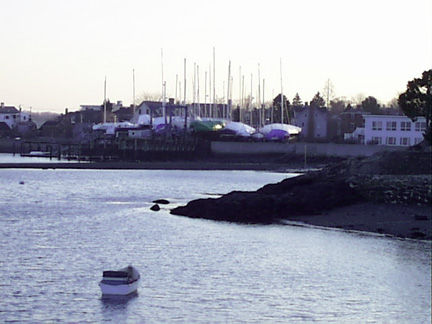 What
could be more distinctly characteristic of Marblehead -- once
known near and far as the Yachting Capital of the World -- than
a yacht yard? The story of Graves Yacht Yards is the story of
the birth and growth of one of Marblehead's oldest and most famous
businesses. It's also the story of the Graves family. What
could be more distinctly characteristic of Marblehead -- once
known near and far as the Yachting Capital of the World -- than
a yacht yard? The story of Graves Yacht Yards is the story of
the birth and growth of one of Marblehead's oldest and most famous
businesses. It's also the story of the Graves family.
A far cry from the one-horse operation begun in the late nineteenth
century by my father, James E. Graves, known to all his contemporaries
as Al (which was a Marblehead corruption of his middle name,
Elbridge) to the familiar operation today with two full-service
yards and known in yachting circles all over the world for its
excellence and service. I often wonder what my Dad would say
if he could come back today to see what has been accomplished.
His little business has grown so far beyond anything he ever
dreamed possible that I'm sure he would be very surprised and
proud of what has been achieved.
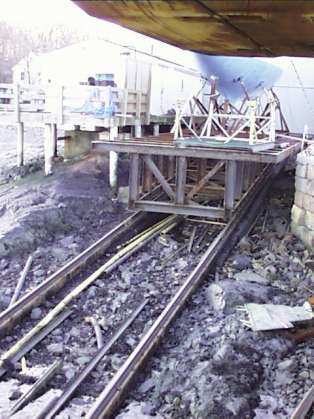
Born in Marblehead on January 1, 1860, the son of Eleazer T.
and Olive Perkins (Emery) Graves of Ellsworth, Maine, James received
a general education in the public schools of his hometown. As
a young man, he worked for a time at farming and Ester Hudson
Roads, who later became his wife, was employed by the Roberts
Box Shop in Marblehead as a teamster, transporting by a horse-drawn
wagon the shoe boxes manufactured there to the shoe factories
in nearby Lynn. Ester was the daughter of Samuel Roads, Jr.,
author of The History and Traditions of Marblehead. She
worked in the Roberts Box Shop making the shoeboxes and that
is how she met my Dad. They were married in 1895 and set up housekeeping
in what had been a barn near the beach on the Graves property
on Harding's Lane. My father converted the barn into a home for
his new bride. A portion of the old Graves homestead remains
standing today as a part of the modern apartment building owned
and operated by his youngest grandson. And, as was the custom
in those days, my father's parents lived with them until their
deaths, both in 1896.
Graves Yacht Yards began almost by accident. Dory racing was
a popular sport among many of the young people in Marblehead
around the turn of the century. They were rowing races and my
father, a big man and very strong, was always successful in these
exciting races. Just for the fun of it, he decided to build a
dory in one of the small buildings at Little Harbor near the
water. This building is still standing, although it has been
remodeled into a garage and small studio, and it is still in
the Graves family. This dory proved to be a faster boat, and
Dad found that he did even better in the races with this new
design. Other competing oarsmen asked him to build dories for
them, and Graves was underway. A good friend and neighbor, Bowden
Crowninshield of the famous Crowninshield family living on nearby
Peach's Point, became interested in these new dories and asked
my father to build some for him, including a 19-footer which
Mr. Crowinshield took to Germany to a race in the year 1906.
It was because of Bowden's success in that race, that he became
interested in helping my father to begin building larger yachts.
His advice and assistance in the architectural and constructional
aspects of boatbuilding was invaluable in the founding of Graves
Yacht Yards.
In those early days, the boats handled by the yard were stored
in the open on their cradles on the beach where several storage
sheds now stand. They were covered with heavy tarpaulins for
protection from the punishing winter storms. Marblehead winters
in those days of innocence were vicious including the
storm of February 1898, when the steamer Portland sank off Marblehead.
History records the power of that storm. I remember hearing it
referred to many, many times in my youth. When the storms came,
their fury and and destructiveness would cause the seas to surge
up over the ledges and beach of Little Harbor and pour into the
low-lying areas flooding everything nearby. I can remember having
our home flooded, and the only way of leaving or coming to the
house was by boat, with everything awash all around.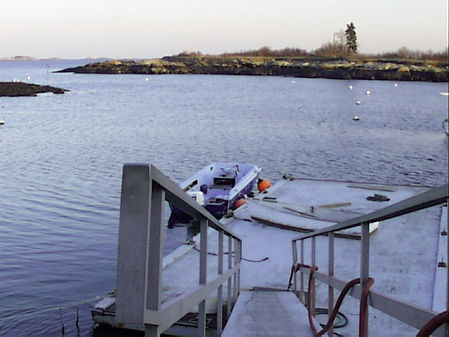
A small railway for hauling and launching the boats had been
installed near the house. In those days, the power source for
operations was provided by a horse that walked around and around
the drum upon which the cable was wound, and which hauled the
boats. The horse was so trained that he would stop or go on the
signal of a whistle produced by his trainer, Henry Cloutman.
Henry was one of my father's earliest employees and the grandfather
of Bob Cloutman who operated Cloutman's Boat Yard in modern times.
Launching a boat, on the other hand, was a wild, splashing affair,
and hauling them out had to be done on the high tide, with gravity
supplying the needed energy. The stop blocks were placed beneath
the wheels of the carriage on the railway to keep them from moving
until all was ready. Then they were removed all together, and
the boat in its cradle on the carriage would begin to slide down
the railway, slowly at first and then picking up speed as it
went, until it raced down the ramp, plunging into the water,
sending a great and grand salt spray in all directions. Then
there it was, if all went well, floating in the ocean, off its
cradle which was still firmly lashed to the carriage, now underwater.
During the years, 1905 to 1910, or so, my father built the first
seawalls around the yards and back-filled to provide more room
for the yards and much better protection from the storms. On
the first construction phase of the walls and before the wall
was capped, a storm swept in and tore out most of his work, but
characteristic of his indomitable spirit and persistence, he
destroyed everything. My Dad pressed on, rebuilding and repairing
the forms, pouring new cement and finishing the new seawall.
My Dad built those walls well, and parts of those walls are still
standing today, although the Great Storm of February 6-7, 1978,
wrought severe damage in the entire length. 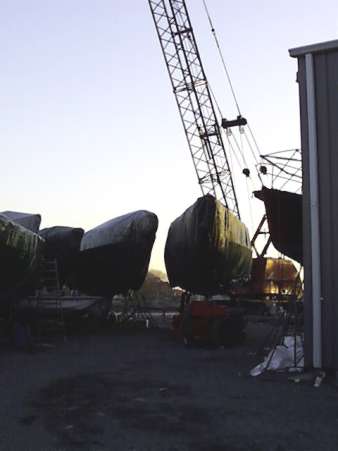
The fill we used for backfilling and increasing the yard space
was provided by the Town's dump trucks bringing in their loads
of refuse. There were two unexpected results from this alliance,
one bad and one good. It was not long before we were nearly overrun
with rats which came in with or, maybe, that followed the trucks,
knowing the determination of Marblehead wharf rats. And then
later, we found to our amazement that a beautiful crop of delicious
mushrooms had somehow seeded from the refuse and grown profusely
in the damp dark climate of the storage sheds.
Graves Yacht Yards' capabilities and facilities for building,
servicing, maintaining and storing large yachts and boats were
greatly expanded by the construction of the seawalls. The railway
was now motor driven, and the launching of the boats was smoothly
controlled. The amazing and exciting launches of the past that
captivated the children of Marblehead were now a thing of the
past. Now the yachts were slowly lowered by cable, carefully,
gently, exactly. Large and additonal storage sheds were built
on the new land inside the walls. On the opposite side of the
yard, near the fishermen's shanties and near the backyards of
the neighbors' houses on Beacon Street, were our shops for the
painters, riggers, and machinists. The long mill shops where
the boats were actually built and where heavy repairs were made
stood proudly, their great doors opening outward directly onto
the railway to the sea.
At the top of a long flight of stairs attached precariously to
the outside of the building next to the mill was a tiny office
where my mother's sister, Edith Russell (Roads) Copeland, carefully
kept and guarded my father's books and records. Working at a
rolltop desk with nothing even resembling a typewriter or an
adding machine, she did everything by hand. She was well known
to be a bookkeeper and organizer without equal. "Auntie,"
as all who knew her called her, was clearly a genius at her job
and was largely responsible for my father's business success
in those early years. Without Auntie's keen and careful watch
over all financial matters and record keeping, the history of
Graves Yacht Yards would surely have been lost. She was an invaluable
asset, who worked quietly without fanfare.
The tide was a constant problem in Little Harbor. Nothing of
any size would be handled at any time, except exactly at high
tide. At low tide the deep thick growth of eel grass on the easterly
side of the yard made it necessary to actually drag small boats
and dories by hand into the deeper water by the end of the reef
of rocks running out from the end of Brown's (or Orne's) Island.
We used to refer to those rocks as the "Ring Bolt"
because of a huge ring secured to the rock at the very end of
them where a beacon had once been standing to mark the rocks
to passing vessels. At that time, the upper end of Marblehead
Harbor was also thick with eel grass, and eel fishing was great
fun.
To correct this low water situation in Little Harbor, a basin
was dredged from the "Ring Bolt" to the seawall on
that side of the yard around 1915. This made it possible to haul
and launch boats at almost any tide. At that time, also, a new
railway, float and runway were built at that end of the yards,
again, improving the yard's facilities and capabilities, and
making it possible now to handle the largest and heaviest yachts.
Around this time, my father designed a new and more rugged towboat.
He named her Selmilede. Boats are historically named after
a favorite girlfriend, wife or daughter of the owner. The first
Graves Yacht Yard towboat, the Edith P., was properly
named after my sister. Later there was the Mildred, named
after my other sister. The new boat, broke with tradition and
combined the first three letters of the names of my brother,
Selman, known to most as Jim, Mildred and Edith. The first Selmilede
was sold to a buyer in Boston after only a few years' service,
and the Selmilede II was born from the drafting board
and the saws and hammers in the mill and launched in Little Harbor.
Like her predecessors, she was not only the work boat for the
yard, working hard every day hauling and moving customers' yachts,
but she also became the treasured family boat.
Charlie Stacey was the captain of the Selmilede I knew
best, and what excellent care he took of her! During the work
week, she was busy doing her many jobs and some of them were
really dirty, but on weekends, she was always scrubbed down clean
and gussied up for the Graves family to all go off on a day's
ocean jaunt or on an overnight up the Danvers River or to the
sand dunes of Essex. Charlie always went along as Captain, cook
and chief bottle washer. What great times we had! I remember
that little towboat whenever I look at Selmilede III,
a great old work horse, still in use, but hardly holding a candle
to the purest little boat of all: Silmilede I. Her Graves-designed
hull outlived several engine changes, and her many years of service
were recognized by her being chosen to lead the parade of boats
on such special Town occasions as Sail '78, a massive parade
held at the beginning of the season. Her large forward deck easily
accommodated several talented musicians who always provided exciting
musical accompaniment to the armada of Marblehead yachts.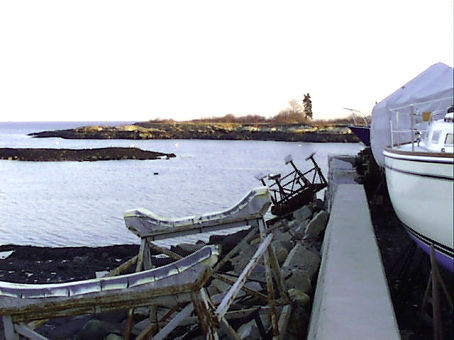
Each of the successive Selmiledes were rugged designs
and built for heavy duty in rough seas. Their outstanding performance
in ocean rescue during the worst local storms and during salvage
work afterwards under the able and competent seamanship of their
several captains won all of them due recognition with the Marblehead
Harbormasters, and with the U.S. Coast Guard. There are few living
Marbleheaders who were not well acquainted with the sight of
one of these famous Selmiledes in action at one time or
another over the years.
Marblehead Race Week in those days was a huge international event,
but perhaps the period leading up to the actual week of racing
was even more exciting for us. The bottom painting was so crucial
in these races that nearly every single racer would want his
boat hauled and the bottom cleaned, smoothed and polished as
well as having all the rigging tuned and racing gear put into
first-class condition. Nearly every racer would also want this
done at the last minute, just before the race, of course. So
the week before Race Week was extraordinarily busy at Graves
Yacht Yards. Boats would be constantly hauled out and moved under
cover as much as possible. The yards would be packed like sardines
to accommodate as many boats as possible and still leave room
enough for the men to get between them to work. One could easily
walk from boat to boat; they were so close together, never touching
the ground. Then on the last day before the beginning of Race
Week, one by one they would be moved to the railway, launched
and towed to their moorings, and the yard would be suddenly very
empty and deserted.
During Race Week itself, everyone in the yard was alert and prepared
to make emergency repairs of just about any kind, so that the
racers would not have to miss a single start. The Graves craftsmen
were famous in their day: Ed Goodwin, brother of Frank, the famous
building mover, head of the yard crew; Cill Blackford, Henry
Schofield, and Arthur Eaton, painters; Ernest Lillibridge, Sam
Humphrey and Charlie Lawton, carpenters; Henry Cloutman, yard
man; and Ducky Standley, tin smith. Each of these men, many from
longtime Marblehead families, was a dedicated craftsman and worker
who knew exactly what to do, and took pride in doing it the best
it could be done. These men worked around the clock, getting
the job done, and their reputations were also the reputation
of Graves itself.
In the summer of 1927, a fire destroyed the mill shop completely,
and in replacing it, an entirely new building, the present mill,
was built at right angles to the old one. This allowed the lumber
to go in one end and the finished boat to come out the other,
although it was hardly as simple as that. One of the real pleasures
my father had during the growth era of his business was the construction
of this new mill.
During his ownership and under his management, Al Graves developed
the business from the one-man operation building rowing dories
to the production, maintenance, repairs and storage of boats
and yachts, both sail and power, up to seventy-five feet in length.
At its height, Graves employed over 30 full-time people.
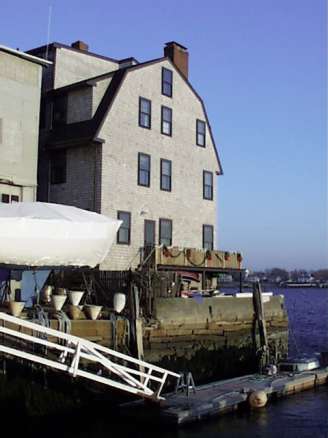 In
1929, the business was officially incorporated under the firm
name of James E. Graves, Inc., and continued to expand under
the able direction of son James and older daughter, Edith, who
took over the position of treasurer and bookkeeper from the faithful
Auntie. James E. Graves struggled with poor health for several
years and died in August of 1930. He had devoted his life to
the family and to the family business. He had served Marblehead
and the sailing and yachting community extremely by creating
a boatyard which ranked among the best in the country, and that
was beloved by all who knew it. In
1929, the business was officially incorporated under the firm
name of James E. Graves, Inc., and continued to expand under
the able direction of son James and older daughter, Edith, who
took over the position of treasurer and bookkeeper from the faithful
Auntie. James E. Graves struggled with poor health for several
years and died in August of 1930. He had devoted his life to
the family and to the family business. He had served Marblehead
and the sailing and yachting community extremely by creating
a boatyard which ranked among the best in the country, and that
was beloved by all who knew it.
In 1933, the Graves Corporation purchased property from the Stearns
& McKay Yacht Yard, another Marblehead boatyard which also
started in the early 1900s. Now there were two Graves Yacht Yards:
one on Front Street near the site of the first customs House
and the present Philip T. Clark Landing and the original boatyard
at Little Harbor, which at that time was adjacent to the charred
remains of Starling Burgess's airplane factory and the old Gas
House Beach, which burned to the ground on the evening of the
"False Armistice" on November 7, 1918. After a few
years the yard at Little Harbor was sold to Henry Basy.
During the development phase of the yard on Front Street,
my brother felt that it was too bad to use the entire harbor
front for business and considered building a house for himself
and his family at the water's edge. While he was thinking about
it, the old Glover Inn which stood across the street from the
northern end of the yard was put up for sale. Jim purchased it
and had it moved across Front Street, through the yard to the
railway, which had been built up to ground level to support the
building. Using the railway the house was moved to its present
location at the harbor end of the yard. The front door of the
old inn now faced the house next door. The other side of the
building, now facing the harbor, became the front of the new
Graves family home. Good capable Frank "Topsy" Goodwin,
famous for his amazing ability to move anything, accomplished
this remarkable move in the nick of time. No sooner was the old
inn safely in its new position than a wild Nor'Easter tore up
the harbor and destroying the railroad where the house had just
been.
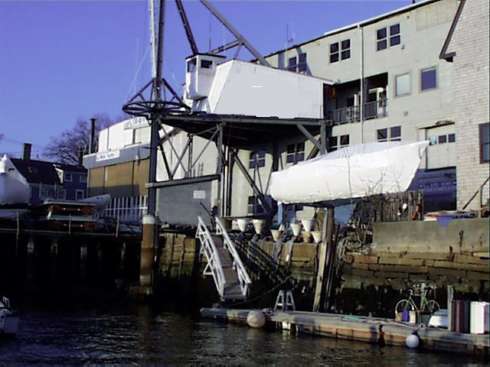
Something else interesting came of moving the old inn to its
new location. Mrs. Roach, the resident then at 9 Goodwin's Court,
the abutting property, was disturbed by rumors that it was to
be converted into a kind of club for Captains and visiting yachtsmen.
She feared that her privacy was to be invaded, her peace and
tranquility destroyed. Without consulting the new owners, she
promptly hired men to erect a spite fence on the edge of her
property so that the entire view from any window of the inn facing
her house was completely blocked. It became a local attraction
with harbor people passing by in their boats or on the ferries
pointing up to the fence and telling their passengers the story
of why it was built. Mrs. Roach died soon after the fence was
built. The real estate agent approached our family as possible
buyers. My sister, Edith, took the opportunity, and we moved
from Beacon Street into 9 Goodwin's Court. One of the first things
she did was to take down the spite fence and use it to close
in a corner of the spacious porches on the house for our new
kitchen. The next summer, passing boat people and their passengers
on the ferries saw the happy ending to the story of the spite
fence.
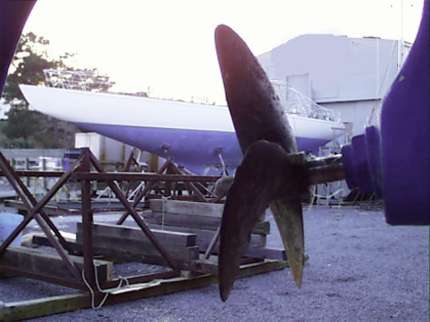 Over
the years, the name and fame of the Graves Yacht Yards spread
far and wide. Such famous yachts as Minotaur, the 1960 United
States Olympic victor of the 5.5 meters at the Bay of Naples
in Italy; Name Sang of West Coast and Honolulu racing fame; Charles
Hovery's Easterner and Boss Anderson's Nefertiti, a 12-meter
candidate for the defense of the America's Cup, all bore the
name of Graves of Marblehead as the builder. Over
the years, the name and fame of the Graves Yacht Yards spread
far and wide. Such famous yachts as Minotaur, the 1960 United
States Olympic victor of the 5.5 meters at the Bay of Naples
in Italy; Name Sang of West Coast and Honolulu racing fame; Charles
Hovery's Easterner and Boss Anderson's Nefertiti, a 12-meter
candidate for the defense of the America's Cup, all bore the
name of Graves of Marblehead as the builder.
During World War I, several of the Graves personnel left for
service with the famous 10th Deck Division. Graves helped flying
boat inventor Starling Burgess in his war defense effort by providing
storage space at the Beacon Street yard for the engines of the
government warplanes being built at his busy plant across Little
Harbor. Also, the V-type wings for an experimental tailless Burgess-Dunne
plane were manufactured at the Graves yard off Beacon Street.
In World War II, both yards were contributing to the national
defense in the production of sixty-four 38-foot picket boats
for the Coast Guard; forty 47-foot tugs for the Army, thirty
30-foot sea-sleds and one 36-foot and one 78-foot sea-sled for
the Army Air Corps. By installing heating systems and protective
ice sheathing for the hulls and by adding suitable deck houses,
several private yachts were also converted for use in the Coast
Guard Reserve. During those years, James E. Graves, Incorporated,
was twice the recipient of the Army-Navy "E" Award
for excellence in the performance of its work, awards which were
celebrated by a big dinner party for employees and management
at the old Adams House, attended by many local and state officials.
In 1949, Graves built uniaks, patterned after Eskimo craft, for
the Army.
After the war, when once again full attention could be given
to the sailing and yachting world, there came a period of building
more and more racing classes. 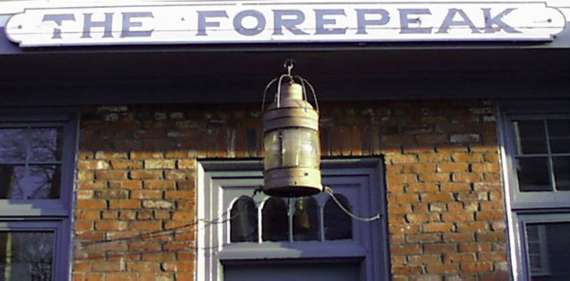 Years
before World War II, class building was begun with the construction
of the Triangles. Now, the extremely popular international 210s
and 110s designed by Marblehead's own C. Raymond Hunt, were built
and sold to owners all over the United States and as far away
as Brazil, Nassau and Honolulu. Later, the one design class,
Constellations, of Graves design were turned out in great numbers. Years
before World War II, class building was begun with the construction
of the Triangles. Now, the extremely popular international 210s
and 110s designed by Marblehead's own C. Raymond Hunt, were built
and sold to owners all over the United States and as far away
as Brazil, Nassau and Honolulu. Later, the one design class,
Constellations, of Graves design were turned out in great numbers.
Over the years, Graves has not only participated in all of the
the important boat shows in New England and in New York City,
but for several years also housed local boat shows on their premises.
These proved to be very popular, but had to be discontinued because
of local fire laws and building codes.
A family business from the beginning, Graves Yacht Yards grew
enormously in capabilities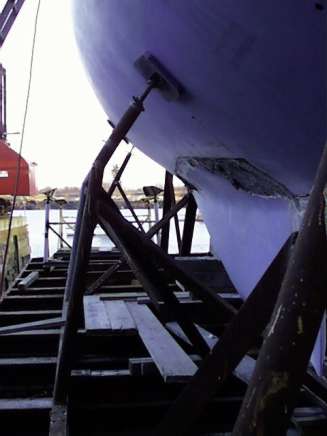 and in reputation between 1925 and 1960 under the personal care
and direction of the second generation of the Graves family.
I joined my brother and sister in the company around 1941, coming
from the mathematics department of Ginn and Company, publishers,
of Boston. As time went on, I grew into the job of helping my
sister Edith with the financial end of things, and eventually
took over when illness prevented her from carrying on. She died
in 1960, and about that time the third generation began to come
on the scene. Since then, through this new generation of Graves,
we saw the development of the Fiberglass Department, the installation
of the versatile traveling crane at the Beacon Street Yard, the
expansion of the stock room to a fully stocked marine store called
the Forepeak on Front Street, and the development of a Yachts
Sale Division at the Marblehead Yacht Yard.
and in reputation between 1925 and 1960 under the personal care
and direction of the second generation of the Graves family.
I joined my brother and sister in the company around 1941, coming
from the mathematics department of Ginn and Company, publishers,
of Boston. As time went on, I grew into the job of helping my
sister Edith with the financial end of things, and eventually
took over when illness prevented her from carrying on. She died
in 1960, and about that time the third generation began to come
on the scene. Since then, through this new generation of Graves,
we saw the development of the Fiberglass Department, the installation
of the versatile traveling crane at the Beacon Street Yard, the
expansion of the stock room to a fully stocked marine store called
the Forepeak on Front Street, and the development of a Yachts
Sale Division at the Marblehead Yacht Yard.
My brother James retired in 1965, but is still interested and
actively involved in the business at times. I retired completely
in 1970.
Looking back over a lifetime and reflecting upon the changes in the
economy over the years, my prayer is that the Graves Yacht Yards, in
the years to come, will be as they are today, among the oldest, if not
the oldest, and the finest yacht yards operating on the northeast
coast.
|

 What
could be more distinctly characteristic of Marblehead -- once
known near and far as the Yachting Capital of the World -- than
a yacht yard? The story of Graves Yacht Yards is the story of
the birth and growth of one of Marblehead's oldest and most famous
businesses. It's also the story of the Graves family.
What
could be more distinctly characteristic of Marblehead -- once
known near and far as the Yachting Capital of the World -- than
a yacht yard? The story of Graves Yacht Yards is the story of
the birth and growth of one of Marblehead's oldest and most famous
businesses. It's also the story of the Graves family.



 In
1929, the business was officially incorporated under the firm
name of James E. Graves, Inc., and continued to expand under
the able direction of son James and older daughter, Edith, who
took over the position of treasurer and bookkeeper from the faithful
Auntie. James E. Graves struggled with poor health for several
years and died in August of 1930. He had devoted his life to
the family and to the family business. He had served Marblehead
and the sailing and yachting community extremely by creating
a boatyard which ranked among the best in the country, and that
was beloved by all who knew it.
In
1929, the business was officially incorporated under the firm
name of James E. Graves, Inc., and continued to expand under
the able direction of son James and older daughter, Edith, who
took over the position of treasurer and bookkeeper from the faithful
Auntie. James E. Graves struggled with poor health for several
years and died in August of 1930. He had devoted his life to
the family and to the family business. He had served Marblehead
and the sailing and yachting community extremely by creating
a boatyard which ranked among the best in the country, and that
was beloved by all who knew it.
 Over
the years, the name and fame of the Graves Yacht Yards spread
far and wide. Such famous yachts as Minotaur, the 1960 United
States Olympic victor of the 5.5 meters at the Bay of Naples
in Italy; Name Sang of West Coast and Honolulu racing fame; Charles
Hovery's Easterner and Boss Anderson's Nefertiti, a 12-meter
candidate for the defense of the America's Cup, all bore the
name of Graves of Marblehead as the builder.
Over
the years, the name and fame of the Graves Yacht Yards spread
far and wide. Such famous yachts as Minotaur, the 1960 United
States Olympic victor of the 5.5 meters at the Bay of Naples
in Italy; Name Sang of West Coast and Honolulu racing fame; Charles
Hovery's Easterner and Boss Anderson's Nefertiti, a 12-meter
candidate for the defense of the America's Cup, all bore the
name of Graves of Marblehead as the builder. Years
before World War II, class building was begun with the construction
of the Triangles. Now, the extremely popular international 210s
and 110s designed by Marblehead's own C. Raymond Hunt, were built
and sold to owners all over the United States and as far away
as Brazil, Nassau and Honolulu. Later, the one design class,
Constellations, of Graves design were turned out in great numbers.
Years
before World War II, class building was begun with the construction
of the Triangles. Now, the extremely popular international 210s
and 110s designed by Marblehead's own C. Raymond Hunt, were built
and sold to owners all over the United States and as far away
as Brazil, Nassau and Honolulu. Later, the one design class,
Constellations, of Graves design were turned out in great numbers. and in reputation between 1925 and 1960 under the personal care
and direction of the second generation of the Graves family.
I joined my brother and sister in the company around 1941, coming
from the mathematics department of Ginn and Company, publishers,
of Boston. As time went on, I grew into the job of helping my
sister Edith with the financial end of things, and eventually
took over when illness prevented her from carrying on. She died
in 1960, and about that time the third generation began to come
on the scene. Since then, through this new generation of Graves,
we saw the development of the Fiberglass Department, the installation
of the versatile traveling crane at the Beacon Street Yard, the
expansion of the stock room to a fully stocked marine store called
the Forepeak on Front Street, and the development of a Yachts
Sale Division at the Marblehead Yacht Yard.
and in reputation between 1925 and 1960 under the personal care
and direction of the second generation of the Graves family.
I joined my brother and sister in the company around 1941, coming
from the mathematics department of Ginn and Company, publishers,
of Boston. As time went on, I grew into the job of helping my
sister Edith with the financial end of things, and eventually
took over when illness prevented her from carrying on. She died
in 1960, and about that time the third generation began to come
on the scene. Since then, through this new generation of Graves,
we saw the development of the Fiberglass Department, the installation
of the versatile traveling crane at the Beacon Street Yard, the
expansion of the stock room to a fully stocked marine store called
the Forepeak on Front Street, and the development of a Yachts
Sale Division at the Marblehead Yacht Yard.